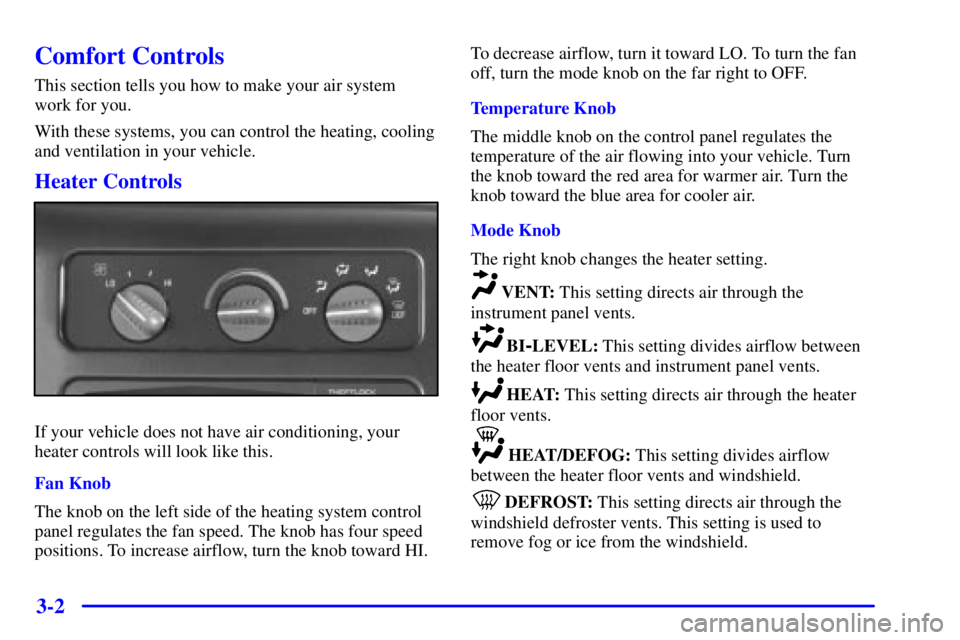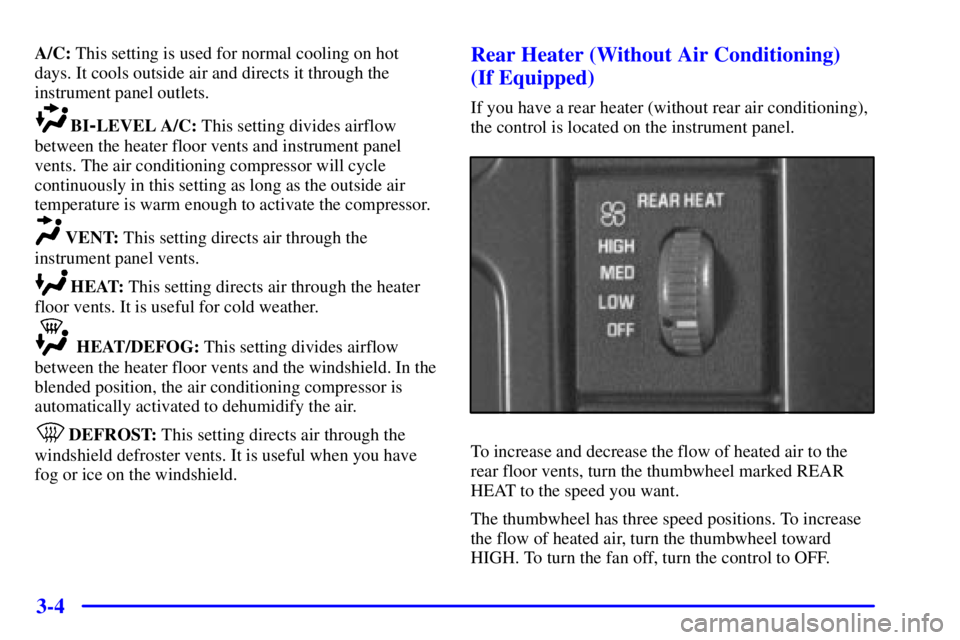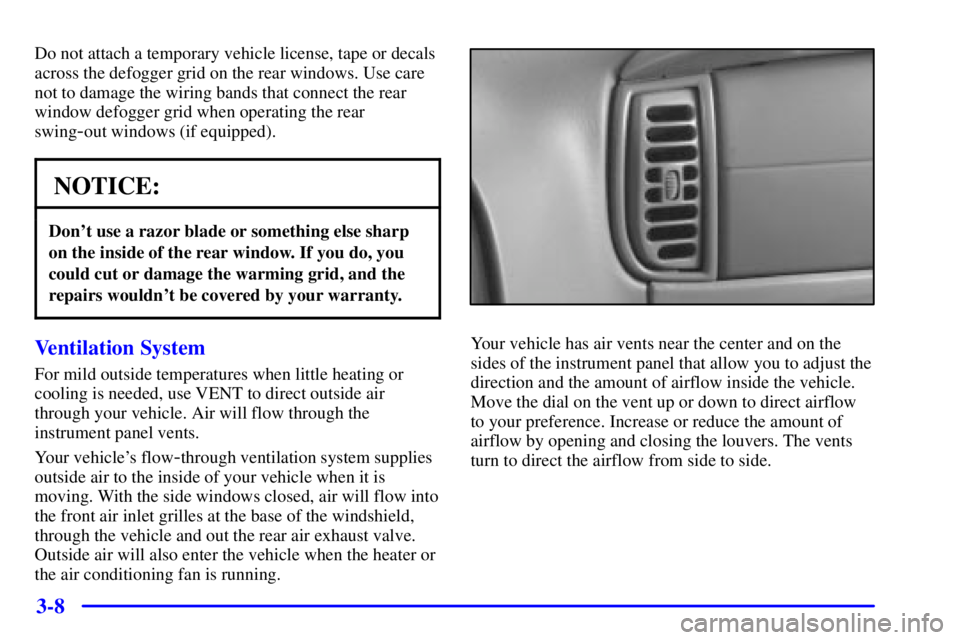Page 13 of 412
Service Station Guide
Oil Viscosity
Engine Oil
See Section 6*
Engine Oil Dipstick
See Section 6*
Fuel
See Section 6*
Cooling System
See Section 5*
Hood Release
See Section 6
Windshield Washer
Fluid
See Section 6
Spare Tire
See Section 5
Battery
See Section 6
Fuel Door
See Section 6*
Tire Pressure
See Section 6
For
a More
Detailed Look at
What's Under the Hood
See Section 6*
*For vehicles equipped with a diesel engine, see the Diesel Engine Supplement
Page 82 of 412

2-5
CAUTION:
It can be dangerous to drive with the rear door(s)
or rear swing
-out windows open because carbon
monoxide (CO) gas can come into your vehicle.
You can't see or smell CO. It can cause
unconsciousness and even death.
If you must drive with the rear door(s) or rear
swing
-out windows open or if electrical wiring or
other cable connections must pass through the
seal between the body and the rear door(s) or
rear swing
-out windows:
�Make sure all other windows are shut.
�Turn the fan on your heating or cooling
system to its highest speed with the setting
on VENT, HEAT, or DEFOG.
Additionally, on vehicles with heating/air
conditioning systems, NORM A/C or
BI
-LEVEL A/C can be used. That will
force outside air into your vehicle.
See ªComfort Controlsº in the Index.
�If you have air outlets on or under the
instrument panel, open them all the way.
See ªEngine Exhaustº in the Index.
Keys
CAUTION:
Leaving children in a vehicle with the ignition
key is dangerous for many reasons. A child or
others could be badly injured or even killed.
They could operate the power windows or
other controls or even make the vehicle move.
Don't leave the keys in a vehicle with children.
Page 93 of 412

2-16
Rear Doors
CAUTION:
It can be dangerous to drive with the rear door(s)
or rear swing
-out windows open because carbon
monoxide (CO) gas can come into your vehicle.
You can't see or smell CO. It can cause
unconsciousness and even death.
If you must drive with the rear door(s) or rear
swing
-out windows open or if electrical wiring or
other cable connections must pass through the
seal between the body and the rear door(s) or
rear swing
-out windows:
�Make sure all other windows are shut.
�Turn the fan on your heating or cooling
system to its highest speed with the setting on
VENT, HEAT or DEFOG. Additionally, on
vehicles with heating/air conditioning
systems, NORM A/C or BI
-LEVEL A/C can
be used. That will force outside air into your
vehicle. See ªComfort Controlsº in the Index.
�If you have air outlets on or under the
instrument panel, open them all the way.
See ªEngine Exhaustº in the Index.
To open the rear doors from the outside, pull the handle
towards you to open the passenger's side rear door first.
Page 141 of 412

2-64
NOTICE:
If you keep driving your vehicle with this light
on, after a while, your emission controls may not
work as well, your fuel economy may not be as
good and your engine may not run as smoothly.
This could lead to costly repairs that may not be
covered by your warranty.
Reduced Engine Power
The REDUCED ENGINE
POWER light will come on
when the cooling system
temperature gets too hot
and the engine further
enters the engine coolant
protection mode.
See ªEngine Overheatingº in the Index for
further information.
Oil Pressure Gage
The oil pressure gage shows
the engine oil pressure in psi
(pounds per square inch)
when the engine is running.
Canadian vehicles indicate
pressure in kPa (kilopascals).
Oil pressure may vary with engine speed, outside
temperature and oil viscosity, but readings above the
low pressure zone indicate the normal operating range.
A reading in the low pressure zone may be caused by a
dangerously low oil level or other problem causing low
oil pressure. Check your oil as soon as possible.
Page 146 of 412

3-2
Comfort Controls
This section tells you how to make your air system
work for you.
With these systems, you can control the heating, cooling
and ventilation in your vehicle.
Heater Controls
If your vehicle does not have air conditioning, your
heater controls will look like this.
Fan Knob
The knob on the left side of the heating system control
panel regulates the fan speed. The knob has four speed
positions. To increase airflow, turn the knob toward HI.To decrease airflow, turn it toward LO. To turn the fan
off, turn the mode knob on the far right to OFF.
Temperature Knob
The middle knob on the control panel regulates the
temperature of the air flowing into your vehicle. Turn
the knob toward the red area for warmer air. Turn the
knob toward the blue area for cooler air.
Mode Knob
The right knob changes the heater setting.
VENT: This setting directs air through the
instrument panel vents.
BI-LEVEL: This setting divides airflow between
the heater floor vents and instrument panel vents.
HEAT: This setting directs air through the heater
floor vents.
HEAT/DEFOG: This setting divides airflow
between the heater floor vents and windshield.
DEFROST: This setting directs air through the
windshield defroster vents. This setting is used to
remove fog or ice from the windshield.
Page 147 of 412

3-3 Heater/Air Conditioning Controls
(If Equipped)
If your vehicle has air conditioning, your heater/air
conditioning controls will look like this.
Before using your vehicle's air conditioning, open the
windows to clear the vehicle of hot air.Fan Knob
The knob on the left side of the heating system control
panel regulates the fan speed. The knob has four speed
positions. To increase airflow, turn the knob toward HI.
To decrease airflow, turn it toward LO. To turn the fan
off, turn the mode knob on the far right to OFF.
Temperature Knob
The middle knob on the control panel lets you select the
temperature of the air flowing into the passenger
compartment of your vehicle. This knob will allow you to
adjust the air temperature independently of the function knob
setting. Turn the knob toward the red area for warmer air.
Turn the knob toward the blue area for cooler air.
Mode Knob
The right knob on the control panel changes the
heater/air conditioning setting.
MAX A/C: Turn the right knob to MAX A/C for
maximum cooling. This setting puts the system in the
recirculation mode and helps to maximize your air
conditioner's performance and your vehicle's fuel
economy. This setting also cools the air the fastest. After
the vehicle's interior reaches a comfortable temperature,
turn the knob clockwise to place the air conditioning
system in the A/C mode.
Page 148 of 412

3-4
A/C: This setting is used for normal cooling on hot
days. It cools outside air and directs it through the
instrument panel outlets.
BI-LEVEL A/C: This setting divides airflow
between the heater floor vents and instrument panel
vents. The air conditioning compressor will cycle
continuously in this setting as long as the outside air
temperature is warm enough to activate the compressor.
VENT: This setting directs air through the
instrument panel vents.
HEAT: This setting directs air through the heater
floor vents. It is useful for cold weather.
HEAT/DEFOG: This setting divides airflow
between the heater floor vents and the windshield. In the
blended position, the air conditioning compressor is
automatically activated to dehumidify the air.
DEFROST: This setting directs air through the
windshield defroster vents. It is useful when you have
fog or ice on the windshield.
Rear Heater (Without Air Conditioning)
(If Equipped)
If you have a rear heater (without rear air conditioning),
the control is located on the instrument panel.
To increase and decrease the flow of heated air to the
rear floor vents, turn the thumbwheel marked REAR
HEAT to the speed you want.
The thumbwheel has three speed positions. To increase
the flow of heated air, turn the thumbwheel toward
HIGH. To turn the fan off, turn the control to OFF.
Page 152 of 412

3-8
Do not attach a temporary vehicle license, tape or decals
across the defogger grid on the rear windows. Use care
not to damage the wiring bands that connect the rear
window defogger grid when operating the rear
swing
-out windows (if equipped).
NOTICE:
Don't use a razor blade or something else sharp
on the inside of the rear window. If you do, you
could cut or damage the warming grid, and the
repairs wouldn't be covered by your warranty.
Ventilation System
For mild outside temperatures when little heating or
cooling is needed, use VENT to direct outside air
through your vehicle. Air will flow through the
instrument panel vents.
Your vehicle's flow
-through ventilation system supplies
outside air to the inside of your vehicle when it is
moving. With the side windows closed, air will flow into
the front air inlet grilles at the base of the windshield,
through the vehicle and out the rear air exhaust valve.
Outside air will also enter the vehicle when the heater or
the air conditioning fan is running.
Your vehicle has air vents near the center and on the
sides of the instrument panel that allow you to adjust the
direction and the amount of airflow inside the vehicle.
Move the dial on the vent up or down to direct airflow
to your preference. Increase or reduce the amount of
airflow by opening and closing the louvers. The vents
turn to direct the airflow from side to side.